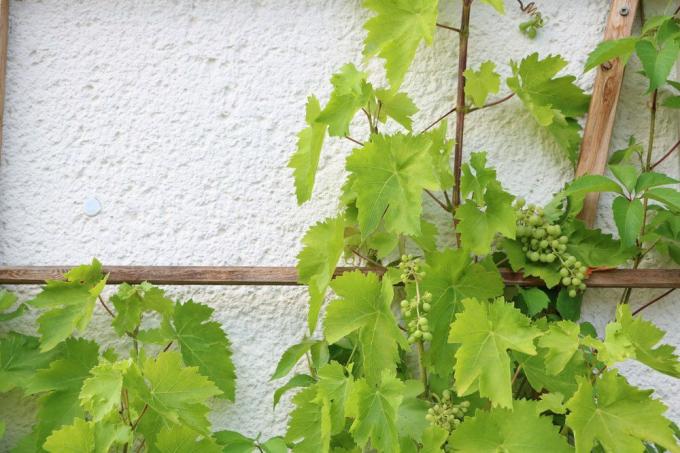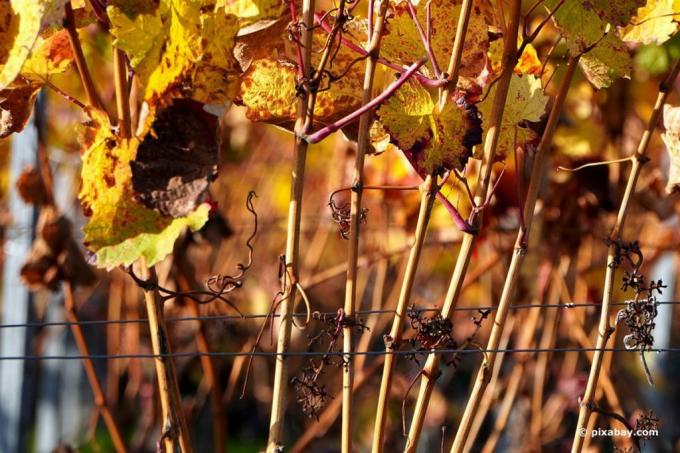
table of contents
- The right pot
- The drainage
- The ideal substrate
- The right location
- A climbing aid
- The right amount of water
- Nutrients and fertilizers
- Underplanting possible
- Support and cut
- The wintering
- frequently asked Questions
A grapevine (lat. vitis vinifera) can be grown not only in the garden, but also in the tub on the balcony or terrace. To ensure that this succeeds, you will find 10 maintenance instructions here.
In a nutshell
- A grapevine can be kept relatively easily in a bucket, barrel or pot
- The wine needs a large planter, plenty of sun, sufficient nutrients in the soil and moist soil
- Drainage in the pot and a climbing aid are essential
- Pruning is just as important in the bucket as it is in free-range farming
- For wintering, the vineyards must be adequately protected from cold and frost
The right pot
Cultivation begins with the choice of the right planter. Wine is deep-rooted and likes to have a lot of space. The pot should therefore be as large and deep as possible. To ensure that excess water drains off, the vessel should have holes in the bottom.

Idea: Use an old wine barrel as a bucket. It's big enough and decorative.
The drainage
So that the grapevine does not suffer from waterlogging, drainage is essential within the bucket. You can create these with drainage gravel, potsherds, grit or expanded clay. Separated from the substrate with a fleece, this creates reliable water drainage.
The ideal substrate
The grapevine likes a slightly acidic soil with a pH of 5.5 to 7.5. Of course, like all other crop plants, she likes it nutrient-rich. You can use potting soil and mix it with a sandy-gravelly topsoil. To make the soil sufficiently acidic, you can add a handful of peat or leafy soil.
The right location
Vines like it warm and sunny. You should therefore provide your plant with an appropriate location. It is also important that the vegetation is sheltered from the wind. It is therefore in good hands on a house wall. Because of its climbing properties, it is especially valued for greening this windbreak or privacy screen.
A climbing aid
If the grapevine is to grow upwards, it also needs a climbing aid in the bucket. Whether made of wood, metal or a zigzag cord. The grapevine wants to go high and needs the right start-up help. A trellis can also be used as a climbing aid.

Idea: An old wooden ladder as a climbing aid goes wonderfully with a grapevine that is planted in an old wine barrel.
The right amount of water
Grapevines need sufficient moisture, but they also don't like waterlogging. The vine should therefore be watered regularly but not too much. Plants in pots usually need more water than in free-range husbandry, as there is less soil available for the roots.
Note: The plant loves nutrient-rich water. You are therefore welcome to use rain or pond water for watering.
Nutrients and fertilizers
In order for the vine to grow beautifully and vigorously, it always needs sufficient nutrients. You should therefore absolutely fertilize the soil of the plant regularly. From March to September the vine should be fertilized with organic liquid fertilizer every 14 days. So that there is no competition for the nutrients, the weeds should be removed from the pot regularly.
Underplanting possible
You are welcome to plant the grapevine under. This looks visually appealing and is sure not to bother your vine. Go particularly well with wine:
- thyme
- rosemary
- lavender
- Cranesbill
Tip: Lavender doesn't just look good and smell good. It also keeps the unpleasant aphids away from the wine.

Support and cut
When keeping the grapevine in the bucket, pruning is very important. In this way, they promote growth and harvest yield and can influence the shape of the vines' growth. At the same time, you protect the crop from fungal diseases. So make a pruning between March and April. In the summer month of June, the green cuttings take place. A vine can grow up to eight meters high, unbraked and uncut. When cutting, you should consider the following things:
- the main pruning takes place in March or April
- Cut the fruit wood as close as possible to the old wood
- it should only be about two centimeters behind the last bud
- use sharp and clean tools to cut
- always cut at an angle so that no blood drips onto the buds
- the summer cut in June is optional
- it is mainly used for the optics and reduces a bushy growth
Note: A radical rejuvenation cut is also necessary every five to ten years so that the yield does not fail.
The wintering
The grapevine can of course be overwintered. Under ideal conditions, it can even live up to a hundred years. When planting in pots, however, much more care is required to bring the vine safely through the winter. To ensure that wintering is successful, you should:
- Wrap the pot with winter protection fleece or bubble wrap
- If possible, place the pot on a styrofoam or wooden plate
- cover a still young plant with winter protection fleece
- Cover the surface of the earth with brushwood, leaves or fir green
- Push the planter as close as possible to the wall of the house
- Pour the wine a little on frost-free days

If the bucket can be transported, you can leave the wine to overwinter in an unheated winter garden or a light attic.
Note: In this case, only bring the wine outside when there is no longer any risk of frost. The fresh buds freeze to death very quickly.
frequently asked Questions
There are many different types of wine on the market. Basically, you should choose a variety that is as robust as possible, as grapevines are very susceptible to diseases. Varieties that are not too vigorous are also suitable for planting in pots. For example the variety "Regent".
You don't have to transplant your grapevine. Since the plants are deep-rooted, they do not tolerate transplanting very well. If you still want to give it a try, you should do so in January or February in the sap dormancy while pruning. When moving to a larger pot, there is less risk that the plant will not survive repotting than when relocating outdoors.
If you do not want to overwinter your vine outdoors, but in a winter garden, attic or cellar, the temperature should by no means exceed 12 degrees Celsius. At higher temperatures there is a risk of premature budding and thus the plant perishing. The winter quarters must therefore not be heated and should be constantly ventilated.



